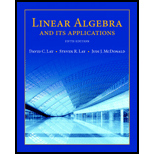
Exercises 27-30 concern the Markov chain model for scoring a tennis match described in Section 10.1, Exercise 31. Suppose that players A and B are playing a tennis match, that the probability that player A wins any point is p = .6, and that the game is currently at “deuce.”
27. How many more points will the tennis game be expected to last?
31. To win a game in tennis, one player must score four points and must also score at least two points more than his or her opponent. Thus if the two players have scored an equal number of points (four or more), which is called “deuce” in tennis jargon, one player must then score two points in a row to win the game. Suppose that players A and B are playing a game of tennis which is at deuce. If A wins the next point it is called “advantage A,” while if B wins the point it is “advantage B.” If the game is at advantage A and player A wins the next point, then player A wins the game. If player B wins the point at advantage A, the game is back at deuce.
a. Suppose the probability of player A winning any point is p. Model the progress of a tennis game starting at deuce using a Markov chain with the following five states.
- 1. deuce
- 2. advantage A
- 3. advantage B
- 4. A wins the game
- 5. B wins the game
Find the transition matrix for this Markov chain.
b. Let p = .6. Find the probability that the game will be at “advantage B” after three points starting at deduce.
Want to see the full answer?
Check out a sample textbook solution
Chapter 10 Solutions
Linear Algebra and Its Applications (5th Edition)
- Please help I'm a working mom trying to help my son last minute (6th grader)! Need help with the blank ones and check the ones he got with full calculation so we can use it to study! Especially the mixed number fractions cause I'm rusty. Thanks in advance!arrow_forward|| 38 5층-11- 6 4 7 2 6arrow_forwardMs.sally has 12 studentsMr Franklin has twice as many students as Ms. Sally.how many students does Mr Franklin have?arrow_forward
- explainwhat is means for a shape to be symmetricarrow_forwarde Grade Breakdown x Dashboard | Big Spring HX Dashboard | Big Spring H x Home | Lesson | Assessm cds.caolacourses.edisonlearning.com/lessons/assessmentplayer Co bigspringsd.org bookmarks Prodigy New Tab my video Brielynn... Algebra 2 Part 1-Exam-EDCP.MA003.A D Question 6 D ? 10 17°F Mostly sunny BSMS Home Significant Events in... Classes 25 26 27 28 29 30 31 32 33 34 35 36 37 38 39 40 Solve using row operations: x-3y= -4; 2x - y = 7 Use the paperclip button below to attach files. Student can enter max 2000 characters BISU DAIAAA X2 X2 T ② Type here Q Search e I ✓ Paragra Oarrow_forward1+3+5+7+ …+300 using gauss’s problemarrow_forward
 Elementary Linear Algebra (MindTap Course List)AlgebraISBN:9781305658004Author:Ron LarsonPublisher:Cengage LearningAlgebra & Trigonometry with Analytic GeometryAlgebraISBN:9781133382119Author:SwokowskiPublisher:Cengage
Elementary Linear Algebra (MindTap Course List)AlgebraISBN:9781305658004Author:Ron LarsonPublisher:Cengage LearningAlgebra & Trigonometry with Analytic GeometryAlgebraISBN:9781133382119Author:SwokowskiPublisher:Cengage

